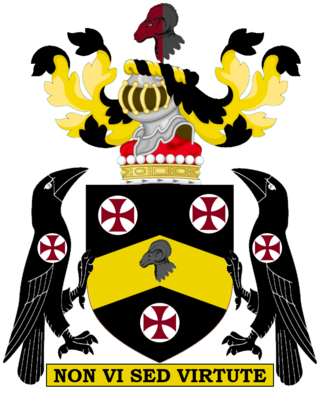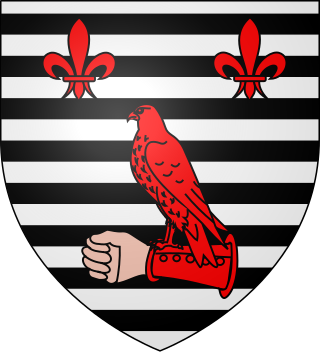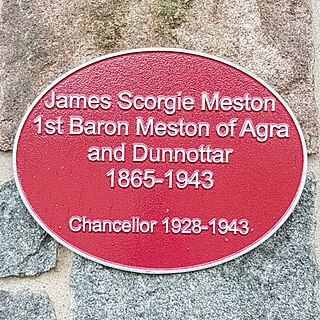Related Research Articles

Viscount Soulbury, of Soulbury in the County of Buckingham, is a title in the Peerage of the United Kingdom. It was created on 16 July 1954 for the Conservative politician Herwald Ramsbotham, 1st Baron Soulbury at the end of his term as Governor-General of Ceylon. He was son of Herwald, son of James and brother of Rev Alexander Ramsbotham. He had already been created Baron Soulbury, of Soulbury in the County of Buckingham, on 6 August 1941, also in the Peerage of the United Kingdom. He was succeeded by his elder son, James, the second Viscount, who lived most of his life in Sri Lanka and gave his maiden speech 13 December 1984. The second Viscount was succeeded by his younger brother, Peter. Better known as Sir Peter Ramsbotham, he was a distinguished diplomat and notably served as British Ambassador to the United States between 1974 and 1977. Sir Peter's son, Oliver, fourth Viscount, succeeded in 2010.

Baron Faringdon, of Buscot Park in the County of Oxfordshire, is a title in the Peerage of the United Kingdom. It was created in 1916 for Sir Alexander Henderson, 1st Baronet, who had previously represented Stafford West and St George's, Hanover Square in the House of Commons as a Liberal Unionist. He had already been created a baronet in 1902. He was succeeded by his grandson, the second Baron. He was the son of the Hon. Harold Henderson, eldest son of the first Baron, who predeceased his father. Lord Faringdon was a member of the London County Council. As of 2017 the titles are held by his nephew, the third Baron, who succeeded in 1977. He is the son of the Hon. Michael Thomas Handerson, second son of the Hon. Harold Henderson.

Baron Inverforth, of Southgate in the County of Middlesex, is a title in the Peerage of the United Kingdom. It was created in 1919 for the Scottish shipping magnate Andrew Weir. He was head of the firm of Andrew Weir & Co, shipowners, and also served as Minister of Munitions from 1919 to 1921. As of 2014 the title is held by his great-grandson, the fourth Baron, who succeeded his father in 1982.

Baron Hemphill, of Rathkenny and of Cashel in the County of Tipperary, is a title in the Peerage of the United Kingdom. It was created on 12 January 1906 for the lawyer and Liberal politician Charles Hemphill, Solicitor-General for Ireland between 1892 and 1895. His elder son, the second Baron, was Crown Prosecutor for County Wicklow. He was succeeded by his younger brother, the third Baron. He was Deputy Chairman of the London County Council from 1907 to 1908. The fifth Baron, who succeeded his father in 1957, assumed by deed poll in 1959 the additional surname of Martyn, which was the maiden name of his father's mother, a first cousin of Edward Martyn. As of 2017 the title is held by the latter's son, the sixth Baron, who succeeded his father in 2012.

Baron Glenarthur, of Carlung in the County of Ayr, is a title in the Peerage of the United Kingdom. It was created in 1918 for the Scottish businessman Sir Matthew Arthur, 1st Baronet. He had already been created a baronet, of Carlung in the County of Ayr, on 28 November 1902. The title of the barony was derived from the joining of his mother's maiden surname name of Glen and his patronymic Arthur.

Baron Amherst of Hackney, in the County of London, is a title in the Peerage of the United Kingdom. It was created on 26 August 1892 for the former Conservative Member of Parliament William Tyssen-Amherst, with remainder, in default of male issue, to his eldest daughter Mary and her issue male. Tyssen-Amherst had previously represented West Norfolk and South West Norfolk in the House of Commons. He was succeeded according to the special remainder by his daughter Mary. She was the wife of Colonel Lord William Cecil, third son of William Cecil, 3rd Marquess of Exeter. As of 2017 the title is held by their great-great-grandson, the fifth Baron, who succeeded his father in 2009. As a male-line descendant of the third Marquess of Exeter he is also in remainder to this peerage and its subsidiary titles the earldom of Exeter and barony of Burghley.

Baron Astor of Hever, of Hever Castle in the County of Kent, is a title in the Peerage of the United Kingdom. It was created in 1956 for John Jacob Astor, a prominent newspaper proprietor and Conservative politician. He was the fourth child of William Waldorf Astor, 1st Viscount Astor. Lord Astor of Hever was succeeded in 1971 by his eldest son, the second Baron, who served as Lord Lieutenant of Kent between 1972 and 1982.

Baron Kilbracken, of Killegar in the County of Leitrim, is a title in the Peerage of the United Kingdom. It was created in 1909 for the senior civil servant Sir Arthur Godley. He was Permanent Under-Secretary of State for India between 1883 and 1909. As of 2010 the title is held by his great-grandson, the fourth Baron, who succeeded his father in 2006.
Baron Moran, of Manton in the County of Wiltshire, is a title in the peerage of the United Kingdom. It was created on 8 March 1943 for the physician Charles Wilson. He is chiefly remembered as Winston Churchill's personal physician during the Second World War and was president of the Royal College of Physicians from 1941 to 1949. His diary of his association with Churchill—that continued to Winston's death in 1965—was published in 1966.
Baron Milner of Leeds, of Roundhay in the City of Leeds, is a title in the Peerage of the United Kingdom. It was created on 20 December 1951 for the Labour politician James Milner. His only son, the second Baron, was one of the ninety elected hereditary peers that were allowed to remain in the House of Lords after the House of Lords Act of 1999. Like his father Lord Milner of Leeds sat on the Labour benches. As of 2018 the title is held by the latter's only son, the third Baron, who succeeded in 2003.
Baron McNair, of Gleniffer in the County of Renfrew, is a title in the Peerage of the United Kingdom. It was created on 4 August 1955 for the lawyer and judge Sir Arnold McNair. He was the first President of the European Court of Human Rights. As of 2010 the title is held by his grandson, the third Baron, who succeeded his father in 1989.
Baron Basing, of Basing Byflete and of Hoddington, both in the County of Southampton, is a title in the Peerage of the United Kingdom. It was created in 1887 for the Conservative politician and former President of the Local Government Board, George Sclater-Booth. On his death the title passed to his eldest son, the second Baron, and then to his son, the third Baron. On the latter's death in 1983 this line of the family failed. The title was inherited by the late Baron's first cousin, the fourth Baron. He was the son of Charles Lutle Sclater-Booth, second son of the first Baron. As of 2010 the title is held by the fourth Baron's grandson, the sixth Baron, who succeeded his father in 2007.
Baron Brocket, of Brocket Hall in the County of Hertford, is a title in the Peerage of the United Kingdom. It was created on 19 January 1933 for the businessman Sir Charles Nall-Cain, 1st Baronet. He was chairman of the brewing firm of Robert Cain & Sons, which had been founded by his father Robert Cain. Before his elevation to the peerage, Nall-Cain had been created a baronet, of the Node, in 1921. His son, the second Baron, represented Wavertree in the House of Commons as a Conservative. As of 2017 the titles are held by the latter's grandson, the third Baron, who succeeded in 1967.

Baron Coleridge, of Ottery St Mary in the County of Devon, is a title in the Peerage of the United Kingdom. It was created in 1874 for the prominent lawyer, judge and Liberal politician Sir John Coleridge. He served as Lord Chief Justice of England from 1880 to 1894. His son, the second Baron, represented Attercliffe in the House of Commons and served as a Judge of the High Court of Justice. As of 2010 the title is held by the latter's great-grandson, the fifth Baron, who succeeded in 1984.
Baron Crawshaw, of Crawshaw in the County Palatine of Lancaster and of Whatton in the County of Leicester is a title in the Peerage of the United Kingdom. It was created on 25 August 1892 for Sir Thomas Brooks, 1st Baronet. He notably served as High Sheriff of Lancashire in 1884. Brooks had already been created a baronet in the Baronetage of the United Kingdom, of Crawshaw Hall and Whatton House, on 9 February 1891. As of 2013 the titles are held by his great-grandson, the fifth Baron, who succeeded his elder brother in 1997.
Baron Cawley, of Prestwich in the County Palatine of Lancaster, is a title in the Peerage of the United Kingdom. It was created in 1918 for the Liberal politician Sir Frederick Cawley, 1st Baronet. He had previously represented Prestwich in the House of Commons and served as Chancellor of the Duchy of Lancaster from 1916 to 1918. Before his elevation to the peerage, Cawley had been created a baronet, of Prestwich in the County Palatine of Lancaster, in the Baronetage of the United Kingdom, in 1906. His grandson, the third Baron, notably served as Deputy Chairman of Committees in the House of Lords from 1958 to 1967. As of 2023 the titles are held by the latter's eldest son, the fourth Baron, who succeeded in 2001.
Baron Cochrane of Cults, of Crawford Priory in the County of Fife, is a title in the Peerage of the United Kingdom. It was created in 1919 for the Liberal Unionist politician and former Under-Secretary of State for the Home Department, the Hon. Thomas Cochrane. He was the second and youngest son of Thomas Barnes Cochrane, 11th Earl of Dundonald. As of 2017 the title is held by the first Baron's great-grandson, the fifth Baron, who succeeded his father in that year.
Baron Clwyd, of Abergele in the County of Denbigh, is a title in the Peerage of the United Kingdom. It was created in 1919 for the Liberal politician Sir John Roberts, 1st Baronet, who had previously represented Denbighshire West in the House of Commons. He had already been created a Baronet, of Brynwenallt in the parish of Abergele in the County of Denbigh, in the Baronetage of the United Kingdom in 1908. Lord Clwyd's father John Roberts had earlier been Member of Parliament for Flint from 1878 to 1892. As of 2016 the titles are held by his great-grandson, the fourth Baron, who succeeded his father in 2006.

Baron Ritchie of Dundee, of Welders in the Parish of Chalfont St Giles in the County of Buckingham, is a title in the Peerage of the United Kingdom. It was created in 1905 for the Conservative politician Charles Ritchie. He was Home Secretary between 1900 and 1902 and Chancellor of the Exchequer between 1902 and 1903.

James Scorgie Meston, 1st Baron Meston, was a prominent British civil servant, financial expert and businessman. He served as Lieutenant-Governor of the United Provinces of Agra and Oudh from 1912 to 1918.
References
- ↑ "No. 31669". The London Gazette . 2 December 1919. p. 14920.
- ↑ Debrett's Peerage. 2019. p. 3623.
- Hesilrige, Arthur G. M. (1921). Debrett's Peerage and Titles of courtesy. London: London: Dean & son, limited. p. 626.
- Kidd, Charles, Williamson, David (editors). Debrett's Peerage and Baronetage (1990 edition). New York: St Martin's Press, 1990.[ page needed ]
- Leigh Rayment's Peerage Pages [ self-published source ][ better source needed ]
